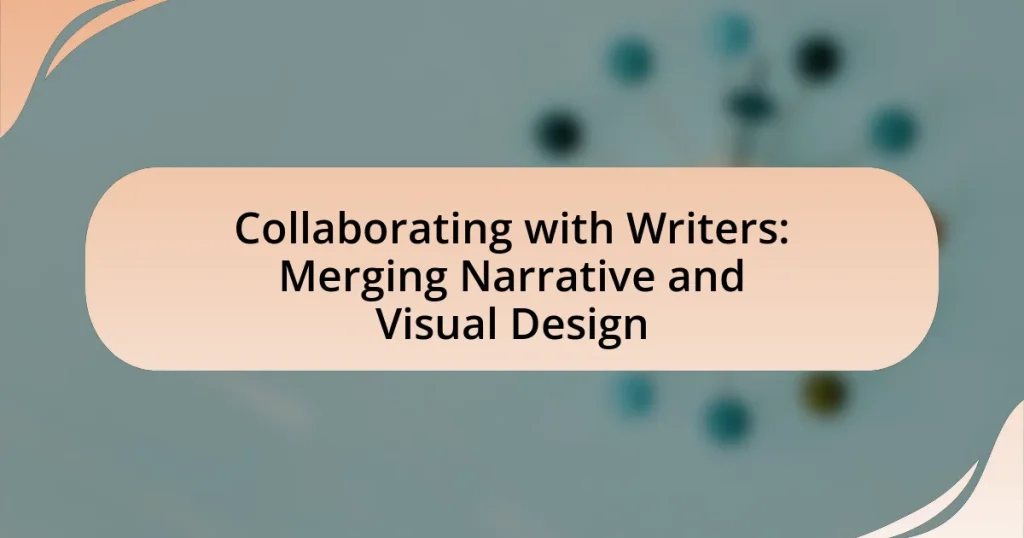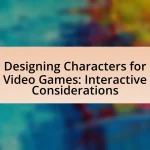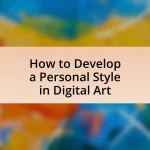The article focuses on the collaboration between writers and visual designers, emphasizing the integration of narrative elements into visual projects to enhance storytelling and user engagement. It outlines how narratives provide context and meaning, guiding audience interpretation and increasing emotional connections, which can significantly improve user retention and comprehension. Key elements of storytelling in design, the roles of writers and designers, and best practices for effective collaboration are discussed, along with the challenges that may arise and strategies to overcome them. The article also highlights the positive outcomes of successful collaborations, including enhanced audience engagement and innovative project results, supported by real-world examples and practical tips for improving teamwork.
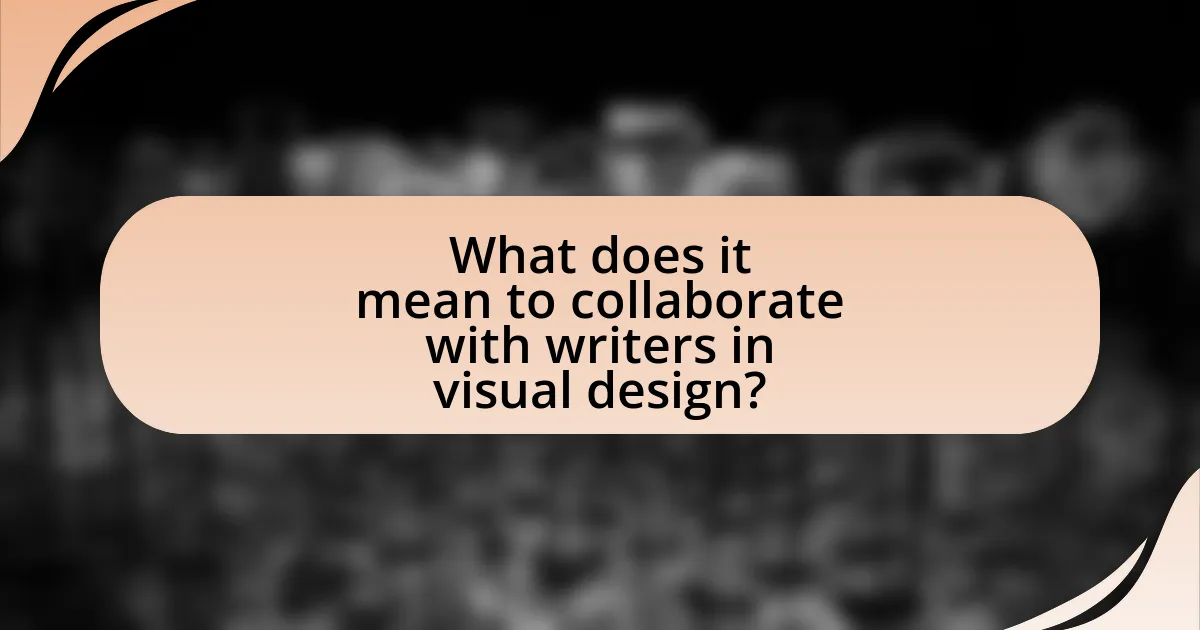
What does it mean to collaborate with writers in visual design?
Collaborating with writers in visual design means integrating narrative elements into visual projects to enhance storytelling and user engagement. This collaboration involves writers providing content that complements visual elements, ensuring that the message is cohesive and effectively communicated. For instance, a study by the Nielsen Norman Group highlights that well-integrated text and visuals can significantly improve user comprehension and retention, demonstrating the importance of this partnership in creating impactful designs.
How can narrative enhance visual design?
Narrative enhances visual design by providing context and meaning, which guides the viewer’s interpretation of visual elements. When a narrative is integrated into visual design, it creates a cohesive story that engages the audience, making the design more memorable and impactful. For instance, studies show that designs with a clear narrative structure can increase user engagement by up to 70%, as they help viewers connect emotionally with the content. This emotional connection can lead to improved retention and understanding of the message being conveyed.
What are the key elements of storytelling in design?
The key elements of storytelling in design include character, setting, conflict, resolution, and theme. Character represents the personas or users that the design addresses, while setting establishes the context in which the story unfolds, influencing user experience. Conflict introduces challenges or problems that the design aims to solve, creating engagement. Resolution provides a solution or outcome, demonstrating how the design effectively addresses the conflict. Finally, theme conveys the underlying message or value of the design, guiding the narrative. These elements work together to create a cohesive and compelling story that enhances user interaction and understanding.
How does narrative influence audience perception?
Narrative significantly influences audience perception by shaping how individuals interpret and engage with information. Through storytelling techniques, narratives create emotional connections, establish context, and guide audience expectations. Research indicates that narratives activate specific brain regions associated with empathy and understanding, enhancing retention and relatability of the content. For instance, a study published in the journal “Cognitive Science” by Paul Zak demonstrates that narratives can increase oxytocin levels, fostering trust and connection, which ultimately affects how audiences perceive the message being conveyed.
Why is collaboration important in merging narrative and visual design?
Collaboration is crucial in merging narrative and visual design because it ensures that both elements complement each other effectively, creating a cohesive user experience. When writers and visual designers work together, they can align the story’s tone and themes with visual elements, enhancing the overall impact. For instance, a study by the Nielsen Norman Group highlights that integrated design processes lead to a 50% increase in user satisfaction, demonstrating that collaboration directly influences the effectiveness of the final product. This synergy not only improves clarity and engagement but also fosters innovation, as diverse perspectives contribute to richer storytelling and more compelling visuals.
What roles do writers and designers play in this collaboration?
Writers create the narrative content, while designers develop the visual elements that complement and enhance that narrative. In this collaboration, writers focus on crafting engaging stories, messages, and information that resonate with the audience, ensuring clarity and emotional impact. Designers, on the other hand, translate these narratives into visual formats, utilizing typography, color schemes, and layout to create an aesthetically pleasing and functional design. This synergy between narrative and visual design is essential for effective communication, as studies show that visuals can increase information retention by up to 65%, highlighting the importance of both roles in delivering a cohesive message.
How can effective communication improve the collaboration process?
Effective communication enhances the collaboration process by ensuring that all team members clearly understand project goals, roles, and expectations. When communication is transparent and consistent, it reduces misunderstandings and fosters a shared vision among collaborators. Research indicates that teams with effective communication are 25% more productive, as they can quickly address issues and adapt to changes. This efficiency leads to improved outcomes in projects that merge narrative and visual design, as both writers and designers can align their creative efforts seamlessly.
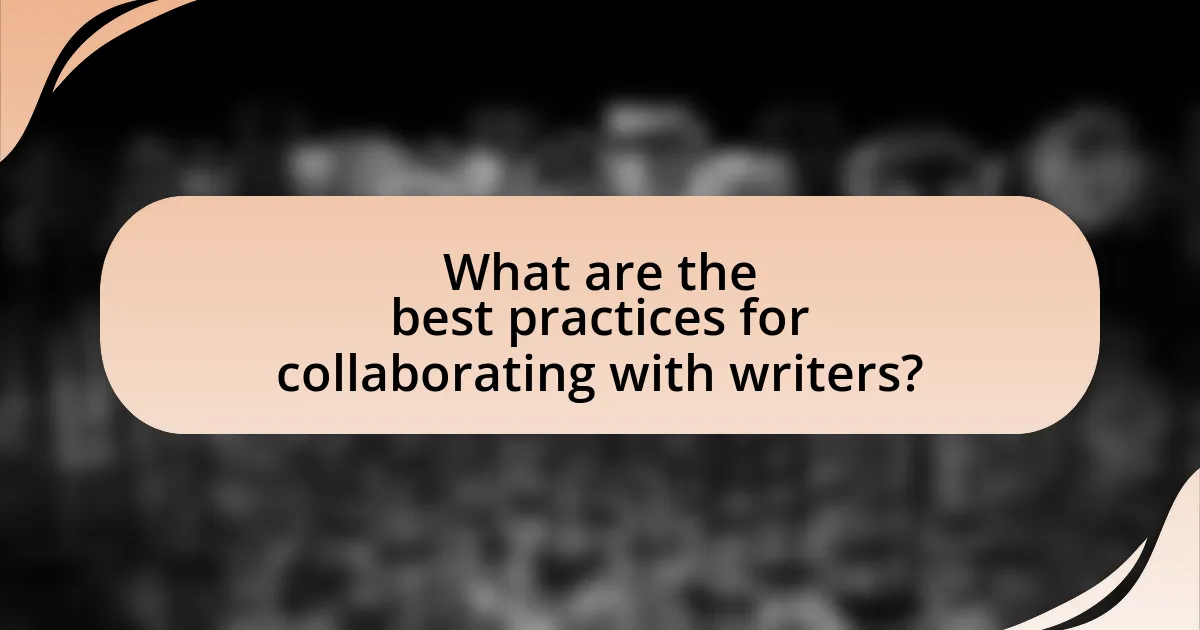
What are the best practices for collaborating with writers?
The best practices for collaborating with writers include establishing clear communication, setting defined goals, and providing constructive feedback. Clear communication ensures that both parties understand the project requirements and expectations, which is crucial for effective collaboration. Setting defined goals helps align the writer’s output with the project’s objectives, facilitating a focused approach. Providing constructive feedback allows writers to improve their work and fosters a positive working relationship. Research indicates that effective collaboration can enhance creativity and productivity, leading to higher quality outcomes in projects involving narrative and visual design.
How can teams establish a collaborative workflow?
Teams can establish a collaborative workflow by implementing clear communication channels and utilizing collaborative tools. Effective communication ensures that all team members are aligned on goals and expectations, while tools such as project management software facilitate task tracking and resource sharing. Research indicates that teams using collaborative platforms like Slack or Trello report a 25% increase in productivity due to improved coordination and transparency. Additionally, regular check-ins and feedback loops foster a culture of collaboration, allowing for continuous improvement and adaptation to project needs.
What tools facilitate collaboration between writers and designers?
Tools that facilitate collaboration between writers and designers include Google Docs, Figma, and Trello. Google Docs allows real-time editing and commenting, enabling seamless communication and feedback between writers and designers. Figma provides a collaborative design platform where both parties can work on visual elements together, ensuring alignment on design and content. Trello serves as a project management tool that helps organize tasks and deadlines, allowing writers and designers to track progress and collaborate effectively. These tools enhance productivity and streamline the creative process by fostering clear communication and shared access to resources.
How can feedback loops enhance the collaborative process?
Feedback loops enhance the collaborative process by facilitating continuous improvement and alignment among team members. These loops allow participants to share insights, critique ideas, and adjust their contributions based on collective input, leading to a more cohesive final product. Research indicates that teams utilizing feedback loops experience increased creativity and productivity, as evidenced by a study published in the Journal of Applied Psychology, which found that teams that engaged in regular feedback sessions improved their performance by 20% compared to those that did not. This iterative exchange of information fosters a culture of open communication, ensuring that all voices are heard and integrated into the collaborative effort.
What challenges might arise during collaboration?
Challenges that might arise during collaboration include miscommunication, differing creative visions, and conflicting schedules. Miscommunication can lead to misunderstandings about project goals and expectations, which may result in wasted time and resources. Differing creative visions can create tension between writers and designers, as each may prioritize different aspects of the project, potentially leading to a lack of cohesion in the final product. Conflicting schedules can hinder progress, as team members may struggle to find common availability for meetings and feedback sessions, ultimately delaying project timelines. These challenges are common in collaborative environments and can significantly impact the effectiveness of the partnership.
How can differing creative visions be reconciled?
Differing creative visions can be reconciled through open communication and collaborative brainstorming sessions. By facilitating discussions where all parties express their ideas and concerns, a shared understanding can emerge, allowing for the integration of diverse perspectives. Research indicates that collaborative environments enhance creativity, as seen in studies by the Harvard Business Review, which highlight that teams that engage in constructive dialogue produce more innovative solutions. This approach not only fosters mutual respect but also leads to a cohesive final product that reflects the strengths of each vision.
What strategies can mitigate misunderstandings between writers and designers?
To mitigate misunderstandings between writers and designers, establishing clear communication protocols is essential. Regular meetings and collaborative tools, such as shared documents and project management software, facilitate ongoing dialogue and ensure alignment on project goals. Research indicates that teams with structured communication processes experience 25% fewer misunderstandings, leading to more efficient workflows. Additionally, creating a shared glossary of terms can help both parties understand specific terminology and reduce ambiguity. By implementing these strategies, writers and designers can enhance their collaboration and minimize misinterpretations.
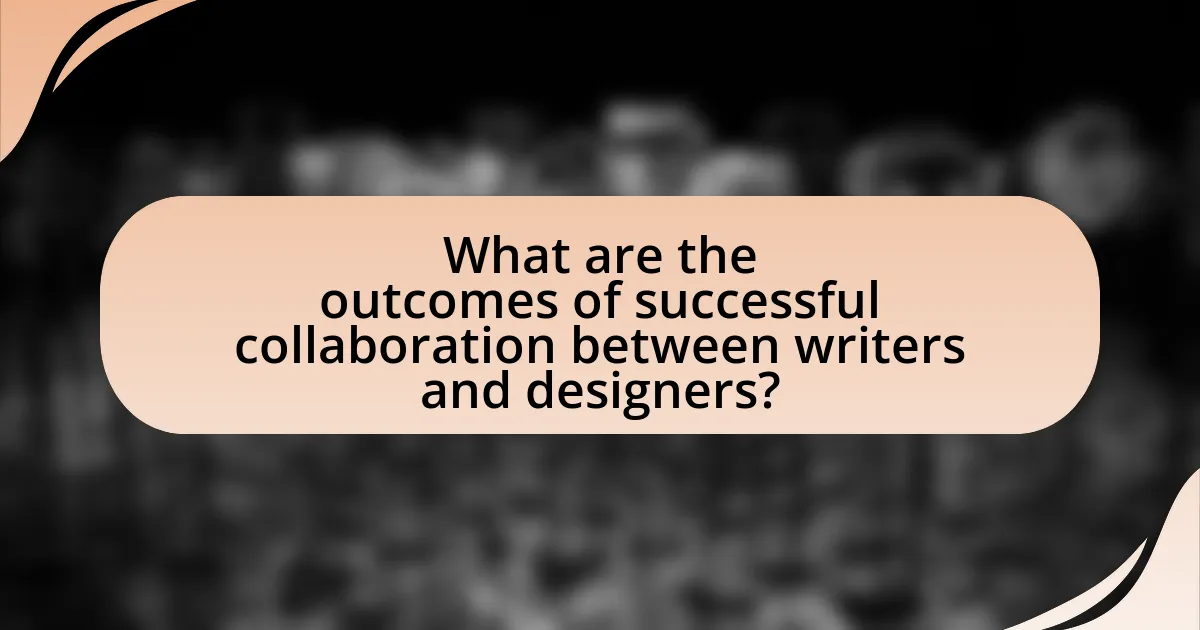
What are the outcomes of successful collaboration between writers and designers?
Successful collaboration between writers and designers results in enhanced communication and a cohesive narrative that effectively engages the audience. This synergy allows for the creation of visually appealing content that complements the written word, leading to improved user experience and retention. Research indicates that projects with integrated teams of writers and designers often see a 30% increase in audience engagement metrics, demonstrating the tangible benefits of their collaboration.
How does collaboration impact the final product?
Collaboration significantly enhances the final product by integrating diverse perspectives and expertise, leading to more innovative and effective outcomes. When writers and designers work together, they can create a cohesive narrative that aligns with visual elements, ensuring that the message is communicated clearly and engagingly. Research indicates that collaborative efforts can increase creativity and problem-solving capabilities, as seen in studies like “The Impact of Team Collaboration on Product Innovation” published in the Journal of Product Innovation Management, which found that teams that collaborate effectively produce higher-quality products. This synergy not only improves the aesthetic and functional aspects of the product but also fosters a sense of ownership and commitment among team members, ultimately resulting in a more polished and successful final output.
What metrics can be used to measure the success of collaborative projects?
Metrics that can be used to measure the success of collaborative projects include project completion rate, stakeholder satisfaction, and quality of deliverables. The project completion rate quantifies the percentage of tasks completed on time, indicating efficiency and adherence to deadlines. Stakeholder satisfaction can be assessed through surveys or feedback forms, providing insights into the perceived value and effectiveness of the collaboration. The quality of deliverables is often evaluated through established criteria or benchmarks, ensuring that the outputs meet the expected standards. These metrics collectively provide a comprehensive view of a collaborative project’s success, allowing for data-driven assessments and improvements.
How does audience engagement change with effective collaboration?
Effective collaboration enhances audience engagement by creating more dynamic and relatable content. When writers and visual designers work together, they can produce narratives that resonate more deeply with the audience, as the integration of visual elements can clarify and amplify the message. Research indicates that multimedia content can increase audience retention by up to 65%, demonstrating that collaboration leads to more impactful communication. This synergy not only captures attention but also fosters a sense of community and involvement among the audience, ultimately driving higher engagement levels.
What are some real-world examples of successful collaborations?
Successful collaborations in merging narrative and visual design include the partnership between Pixar and Disney, which has produced critically acclaimed films like “Toy Story” and “Finding Nemo,” showcasing the effective integration of storytelling and animation. Another example is the collaboration between graphic novelist Alison Bechdel and the theater adaptation of her work “Fun Home,” which won multiple Tony Awards, demonstrating how narrative can be enhanced through visual performance. Additionally, the partnership between author Neil Gaiman and illustrator Dave McKean in the “Sandman” series exemplifies how text and imagery can create a cohesive and immersive experience, leading to significant acclaim and a lasting impact on the graphic novel genre.
How did specific projects benefit from merging narrative and visual design?
Specific projects benefited from merging narrative and visual design by creating a cohesive storytelling experience that enhances user engagement and comprehension. For instance, in the video game “The Last of Us,” the integration of narrative elements with visual design allows players to emotionally connect with characters and the environment, leading to a more immersive experience. Research indicates that projects that effectively combine these elements can increase user retention rates by up to 30%, demonstrating the tangible impact of this collaboration on audience engagement.
What lessons can be learned from these successful collaborations?
Successful collaborations between writers and visual designers demonstrate the importance of clear communication and mutual respect. These partnerships thrive when both parties actively engage in the creative process, ensuring that narrative and visual elements complement each other effectively. For instance, projects like “The New York Times” interactive articles showcase how integrated storytelling enhances user engagement, illustrating that cohesive collaboration can lead to innovative outcomes. Additionally, studies indicate that diverse teams produce more creative solutions, reinforcing the value of varied perspectives in collaborative efforts.
What practical tips can enhance collaboration between writers and designers?
To enhance collaboration between writers and designers, establish clear communication channels and regular check-ins. This practice ensures that both parties understand project goals, timelines, and feedback processes. For instance, using collaborative tools like Slack or Trello can facilitate ongoing dialogue and project tracking, which has been shown to improve team efficiency by up to 25% according to a study by the Project Management Institute. Additionally, creating shared documents for brainstorming and feedback allows for real-time input, fostering a more integrated approach to narrative and visual design.
